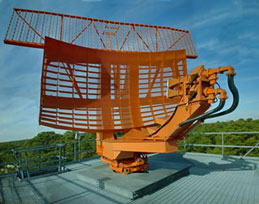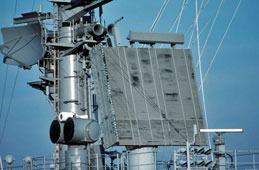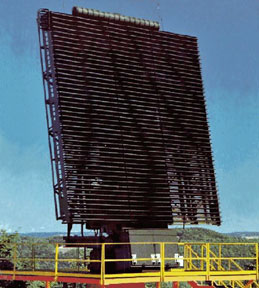Radar Systems
Radar systems cause a considerable amount of concern because of the high peak energy levels used to generate radar pulses. It is not uncommon to hear of power levels from 50,000 Watts to over a 1,000,000 Watts. It is important to understand that these are peak levels, and it is the average power level that is important in terms of body heating. Most radar systems use reflector antennas that form a well-defined beam of energy. Special military radar systems use many active elements to direct the beam of energy. These phased array radars are beyond the scope of this application note.
Determining Average RF Field Levels
Unlike satellite antennas, radar antennas are designed to move constantly. Traditional search radars normally rotate at a constant speed and cover 360 degrees in azimuth. Some military radar systems, such as fire control radars, are designed to move both in azimuth and elevation to track a target. When a search radar is rotating, not only is it transmitting only a small percentage of the time, which is referred to as the duty factor, but it is also only pointed in a given direction part of the time.
The evaluation of a radar system begins with examining the peak power level contained in each pulse and then multiplying the peak level by the duty factor. The duty factor, or duty cycle, is determined by dividing the duration of the pulse—the pulse width—by the total time in one cycle. For example, a typical search radar might send out a one-microsecond (μsec) pulse 1,000 times per second. Therefore, the period is 1,000 μsec (1,000,000 μsec/1,000 pulses). The duty factor is 1/1,000 which is normally expressed as 0.001. Therefore, the average power of a radar system with a peak power level of 1,000,000 Watts that has a maximum duty factor of 0.001 is 1,000 Watts. Most search radars have a horizontal pulse width that ranges from one to three degrees. Therefore, as long as the antenna is rotating and you are far enough away for the beam to be formed, you would be in the beam less than 1 percent of the time. And when you factor in rotation, a radar antenna with an average power of 1,000 Watts results in a time-averaged exposure that is equivalent to less than 10 Watts from a continuous (CW) signal fed into the same size antenna that is stationary. Even if you are close to the antenna, you will be in the beam only about 10 percent of the time, which makes the system equivalent to a constant source of 100 Watts.
RF Safety Solutions can help you with your radar system. Contact us to discuss your application.


